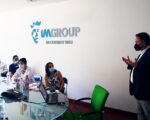How significant is IoT?
With the world facing an unprecedented global challenge of the pandemic, Internet of Things or IoT is making impacts on lives more than ever. IoT enables businesses to continuously connect with their customers in a much safer way. In fact, numerous markets used massive IoT “to gain insights about product performance and find new ways of customer engagement with both new and existing customers.”
GSMA Intelligence which represents the interest of mobile operators worldwide predicted that between 2018 and 2025, the number of global IoT connections will triple to 25 billion, while global IoT revenue will quadruple to $1.1 trillion. It also noted that the “growth will be driven by a proliferation of use cases in the smart building and smart home segments, which will together account for more than half the 16 billion new IoT connections” which is a significant enormous industry. Most countries that utilize IoT come from developed nations such as the United States, United Kingdom, Western Europe and East Asia. However, Africa and Southeast Asia are slowly moving forward within this kind of market.
In corporations, skills and mindset to adopt a “data-driven decision making” becomes the way in the industry. IoT has a vital role in providing this data especially cultural and organizational change. Even studies show that “companies that were in the top third of their industries in making data-driven decisions were, on average, 5 to 6 percent more productive than their peers”.
How is IoT in developing countries?
The prospect of IoT in developing countries is huge but remains limited. According to scholars, internet connectivity, data centers, power resources, and financial challenges are few attributes that made developing countries unable to tap the opportunity of IoT. However, it is equally important to note the heterogeneous culture of these countries. For instance, Southeast Asia, composed of 11 countries but there are more than thousands of languages and hundreds of ethnic cultures. This diverse market is quite challenging for them and for the rest of the world to enter the global arena especially in the arena of IoT.
For you that are interested in being involved with developing countries through IoT, the list below provides key challenges to bear in mind in your dealings.
- Linguistic issues: this is one of the most important aspects of IoT because “[t]hese relate to the translation of a product’s user interface and documentation and may also extend to the translation and re-engineering of any underlying linguistic functionality such as applications programming interfaces (APIs), search engines or wizards.”
- Content and cultural issues: There exist certain practices that must be suitable for the locals. For instance, UK cars must not have the steering wheel on the left. There are also other sensitive “cultural issues concerning the presentation of information (icons, graphics, colors, forms of address, etc.) may also need to be taken into account.”
- Technical issues: An illustration of this is the Arabic Script which is bi-directional requiring redesign and re-engineering. By adapting products that require these scripts it also comes with adapting changes to the code in the case of software, product design, packaging, and other considerations. Arabic scripts are prominent most especially to many Muslims in developing countries.
- Human Capital: A big hiccup to developing countries is the lack of technically knowledgeable personnel. Studies cited that these include Engineers, Scientists and Technicians since IoT is implementing the technologies to build up IoT platforms. Learned personnel is an indispensable requirement for developing countries especially Africa and Southeast Asia since research centers are very limited.
- Behavioral and cultural changes: Many developing countries still have very unstable milieu, ranging from political to economic which vastly affects individual and collective behavior. Brought by colonization in the past, many still are in the act of seceding and separating from their current state.
- Standardization: Lack of a standard is a great challenge in the success of IoT. With limited research in developing countries, it is difficult to establish a product or service that is acceptable to other countries especially to industrialized ones.
What is the most accessible solution?
All of these challenges are not without recourse. There is a way that is within the hands of any person who has the internet.
Localization is the most accessible solution available in the market today that even developing countries could access it. Website Localization is an unoptimized solution since many still don’t know about it yet. However, it is readily available and people are just a click away from gaining it.
In general practice, localization pertains only to the “process of modifying products or services to account for differences in distinct markets” but now with technology, websites are the subject. This idea is projected with UX localization which provides business solutions being mindful in respecting certain cultures in certain countries which businesses are providing their services or products. As some authors said that the localization process is more than a mere but proper text translation.
In fact, UX as a localization tool is developed to cover a broad scale. With this, it requires to interchange translation data. As scholars ideally illustrated “such interchange needs to be both between different systems (e.g., from Manufacturer A’s translation memory to Manufacturer B’s translation memory) and between different system types (e.g., to reuse terminology from a terminology management system in a machine translation lexicon).” Since this process involved a “wide range of highly proprietary formats in use” it is a complex process that must yield a simplified exchange of translation data and information. Today, this industry has grown enormously in the past years and now represents a sizable economic investment.
How does localization address the challenges?
Localization of a product or service is quite time-consuming and requires a deep understanding of complex processes and other aspects in certain society however the beauty of UX localization enables it to cut through the barriers of culture.
When products and services are being localized, it adapts to its milieu and somehow becomes more personalized. Many consumers today are culturally sensitive and by making it “localized” it meets the specific local needs. Although most products and services are provided in English, it is simply not enough. As we can see in the market today, more and more product information is being translated into local languages so that even ordinary people are able to understand.
With almost all industries across the world transforming from traditional to “high-tech” in this technological and digital epoch, IoT is the prime mover in making connectivity and globalization possible. Although it carries a more increasingly complex process but improves efficiency, reduces downtime and yields to a more adaptable market.
In developing countries, limited data and researches remain the great barrier of success for IoT languages. With very significant low numbers of qualified staff, localization sector companies are more opted for hefty sums for training. However, with the emergence of solutions mentioned, more research and data would be available.
Ultimately, the Internet of Things or IoT is a powerful tool in this digital era. With developing countries that are facing quite considerable challenges in the different areas of IOT, it is not without hope.







